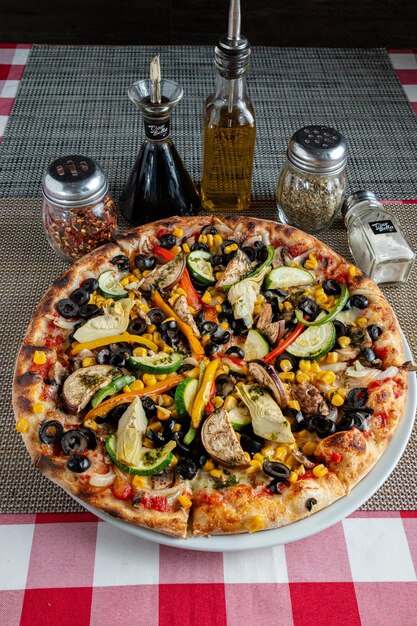Pizzaganic: The Culinary Delight That’s Taking the Food

New dishes and flavors emerge regularly, capturing the hearts and taste buds of food enthusiasts around the globe. One such delightful creation that has recently gained popularity is “pizzaganic.” This unique dish combines the beloved elements of pizza with innovative twists that make it stand out in the crowded world of comfort food. In this article, we will explore the origins of pizzaganic, its ingredients, preparation methods, variations, and why it has become a favorite among food lovers.
What is Pizzaganic?
Pizzaganic is a term that blends “pizza” with “organic,” reflecting a focus on fresh, high-quality ingredients that are often sourced from local farms. The dish typically features a pizza base topped with a variety of organic vegetables, meats, cheeses, and sauces, all crafted to create a harmonious balance of flavors. The pizzaganic concept emphasizes sustainability and health, making it an appealing option for those who are conscious of what they eat.
The Origins of Pizzaganic
While the exact origins of pizzaganic are difficult to pinpoint, it is believed to have emerged in the early 21st century as part of the growing trend towards organic and farm-to-table dining. As more people became aware of the benefits of eating organic foods, chefs and home cooks alike began experimenting with traditional recipes, incorporating fresh, seasonal ingredients into classic dishes.
The pizzaganic movement gained traction in urban areas where health-conscious consumers sought out restaurants and food trucks that offered organic options. As social media platforms like Instagram and TikTok became popular, the visually appealing nature of pizzaganic dishes helped them go viral, further solidifying their place in contemporary cuisine.
Key Ingredients in Pizzaganic
The beauty of pizzaganic lies in its versatility. While the base of the dish remains consistent, the toppings can vary widely based on personal preferences and seasonal availability. Here are some key ingredients commonly found in pizzaganic recipes:

1. Organic Pizza Dough
The foundation of any great pizza is the dough. For pizzaganic, using organic flour is essential. Many recipes call for a simple combination of organic all-purpose flour, water, yeast, and salt. Some variations may include whole wheat or gluten-free flours to cater to different dietary needs.
2. Fresh Tomato Sauce
A rich, flavorful tomato sauce is a must for pizzaganic. Many chefs opt for organic tomatoes, either canned or fresh, and blend them with herbs like basil, oregano, and garlic. The sauce can be cooked down to enhance its flavor or used fresh for a lighter taste.
3. Organic Cheese
Cheese is a crucial component of any pizza, and pizzaganic is no exception. Organic mozzarella is the most common choice, but other cheeses like goat cheese, feta, or vegan cheese alternatives can also be used to create unique flavor profiles.
4. Seasonal Vegetables
One of the hallmarks of pizzaganic is the use of seasonal, organic vegetables. Popular choices include bell peppers, mushrooms, spinach, zucchini, and arugula. These vegetables not only add color and texture but also provide essential nutrients.
5. High-Quality Proteins
For those who enjoy meat on their pizza, pizzaganic offers a variety of organic protein options. Grass-fed beef, free-range chicken, and nitrate-free pepperoni are popular choices. Additionally, plant-based proteins like tempeh or chickpeas can be used for a vegetarian or vegan twist.
6. Fresh Herbs and Spices
To elevate the flavor of pizzaganic, fresh herbs and spices are often added. Basil, oregano, thyme, and rosemary can enhance the overall taste, while red pepper flakes or garlic powder can add a kick of heat.
Preparing Pizzaganic: A Step-by-Step Guide
Creating a delicious pizzaganic at home is a rewarding experience that allows for creativity and customization. Here’s a simple step-by-step guide to making your own pizzaganic masterpiece:
Step 1: Make the Dough
- Ingredients: Combine 2 cups of organic all-purpose flour, 1 teaspoon of salt, 1 teaspoon of sugar, 1 packet of active dry yeast, and 3/4 cup of warm water in a mixing bowl.
- Mix: Stir the ingredients until a dough forms. Knead the dough on a floured surface for about 5-7 minutes until smooth.
- Rise: Place the dough in a greased bowl, cover it with a damp cloth, and let it rise in a warm place for about 1 hour or until it doubles in size.
Step 2: Prepare the Sauce
- Ingredients: In a saucepan, combine 1 can of organic crushed tomatoes, 2 cloves of minced garlic, 1 teaspoon of dried oregano, and salt and pepper to taste.
- Cook: Simmer the sauce over medium heat for about 20 minutes, stirring occasionally to prevent sticking. This will allow the flavors to meld together beautifully.
Step 3: Preheat the Oven
Preheat your oven to 475°F (245°C). If you have a pizza stone, place it in the oven to heat up as well. A hot stone will help achieve a crispy crust.

Step 4: Roll Out the Dough
Once the dough has risen, punch it down to release the air. On a floured surface, roll out the dough into your desired shape, whether it be round, square, or even a fun shape for a themed dinner. Aim for a thickness of about 1/4 inch for a perfect balance of chewy and crispy.
Step 5: Assemble the Pizzaganic
- Spread the Sauce: Use a ladle to spread a generous amount of the prepared tomato sauce over the rolled-out dough, leaving a small border around the edges.
- Add Cheese: Sprinkle a layer of organic mozzarella cheese over the sauce, ensuring even coverage.
- Layer the Toppings: Add your choice of seasonal vegetables and organic proteins. Be creative! Arrange them in a visually appealing manner.
- Finish with Herbs: Sprinkle fresh herbs and spices over the top for added flavor.
Step 6: Bake the Pizzaganic
Carefully transfer the assembled pizzaganic onto the preheated pizza stone or a baking sheet lined with parchment paper. Bake for 12-15 minutes or until the crust is golden brown and the cheese is bubbly and slightly browned.
Step 7: Serve and Enjoy
Once baked, remove the pizzaganic from the oven and let it cool for a few minutes. Slice it into wedges and serve hot. Pair it with a fresh salad or a glass of organic wine for a complete meal.
Variations of Pizzaganic
The beauty of pizzaganic lies in its adaptability. Here are a few variations to consider:
1. Vegan Pizzaganic
For a plant-based version, use vegan cheese and load up on a variety of vegetables. You can also add a drizzle of balsamic glaze for extra flavor.
2. Gluten-Free Pizzaganic
Substitute the traditional pizza dough with a gluten-free flour blend or a cauliflower crust. This option caters to those with gluten sensitivities while still delivering on taste.
3. Breakfast Pizzaganic
Transform pizzaganic into a breakfast dish by adding scrambled eggs, avocado, and a sprinkle of cheese. Top it off with fresh herbs for a morning treat.
4. Dessert Pizzaganic
For a sweet twist, create a dessert pizzaganic using a sweet dough base topped with Nutella, fresh fruits, and a dusting of powdered sugar. This variation is perfect for satisfying your sweet tooth.
Why Pizzaganic is Gaining Popularity
The rise of pizzaganic can be attributed to several factors that resonate with today’s consumers:
1. Health Consciousness
As more people become aware of the importance of healthy eating, pizzaganic offers a guilt-free indulgence. With its focus on organic ingredients, it appeals to those looking to enjoy comfort food without compromising their health.
2. Sustainability
The emphasis on local and organic sourcing aligns with the growing movement towards sustainability in the food industry. Consumers are increasingly seeking out dishes that support local farmers and reduce their carbon footprint.
3. Customization
Pizzaganic allows for endless customization, making it a fun option for gatherings and family meals. Everyone can create their own unique pizza, catering to individual tastes and dietary restrictions.
4. Social Media Appeal
The visually stunning nature of pizzaganic dishes makes them perfect for sharing on social media platforms. The vibrant colors and artistic presentations attract attention, encouraging others to try their hand at making pizzaganic.
Conclusion
Pizzaganic is more than just a trend; it represents a shift towards healthier, sustainable eating without sacrificing flavor. With its roots in organic ingredients and a focus on customization, it has captured the hearts of food lovers everywhere. Whether you’re a seasoned chef or a home cook looking to experiment, pizzaganic offers a delicious canvas for creativity in the kitchen. So gather your ingredients, invite some friends over, and embark on a culinary adventure that celebrates the joy of good food.


